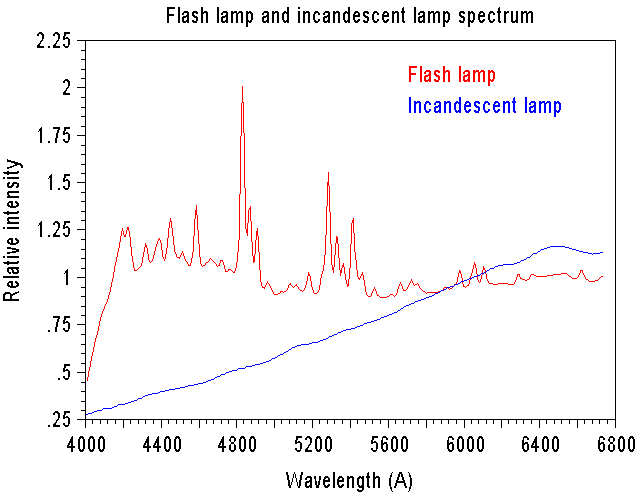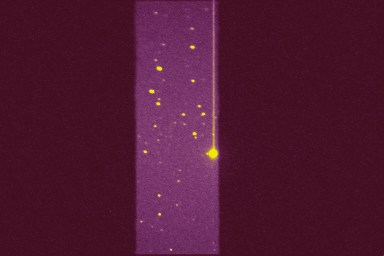5.3.1. Messier 82
Composite of 18 spectra exposed 120 seconds (FSQ-106 + Littrow R=500) under the beautiful sky of Pic du Midi Observatory (french Pyrénées).

Zero order image.

The processed two-dimension spectrum. H-alpha line is at the extreme right. Note that this line is double. The continuum is clearly visible. You can also see airglow atmospheric lines.

The one dimension spectrum. The doublet on the right side is the H-alpha line and the [NII] lines. The measured red-shift is of 230 km/s ± 50 km/s deduced from the position of H-alpha line relative to a neon spectrum (see bellow).
5.3.2. Messier 27
Composite of 11 images exposed 120 seconds. FSQ-106 + Littrow R=500.

![]()

The M27 spectra (Dumbell) is very characteristic of planetary nebulae.
5.3.3. Comet C/2001 A2 (LINEAR)
5.3.4. Some peculiar sources

Spectral calibration by the use of a neon lamp front to the refractor objective. An optimal result is obtained if a diffuser is placed just beyond the objective (not see in this images).

Characteristic spectrum of the very economical neon lamp. The essential of the lines is concentrated in the red part.

Spectral lines identification in a neon lamp.

The neon lamp spectra superimposed to the M82 spectra. Quasi simultaneous acquisition. The comparaison of this spectra permit to reveal galaxies redshift for example.

Moon and sky (twilight) spectrum. This data are corrected from the instrumental responsivity. The spectral profile is typical of sun-like spectrum (type G2V).

Comparison of spectral distribution of flash lamp (from NIKON 950) and incandescent lamp (torch lamp). The result is very different: many spectral appear in the white light of the flash and the incandescent is very red.
Field of the star HD4817 (RA: 00h51m16.5s - DEC: +61°48'20"). Refractor Takahashi FSQ-106 (4.2 inch aperture) and Littrow spectrograph at dispersion of 8 Angstroms per pixel. The observation if made at Pic du Midi Observatory. The sky is very dark (dominated by the 5577 A airglow), but partially cloudy during acquisition.

The zero order image show the field of view. The slit is intentionally for acquire many spectra simultaneous.

Result of a cumulative integration
time of 27 minutes (13 exposures of 60 seconds and 7 exposures of
120 seconds). Spectra of magnitude 13 stars are detected (SNR=4).
The expected limit R magnitude for a 24-inch telescope is of 17
for an hour exposure time. For a situation of emission lines object
(i.e. supernova or nova) this telescope can reveal the nature of
the object to magnitude 18. Click here
for a theoretical estimation of limit magnitude.